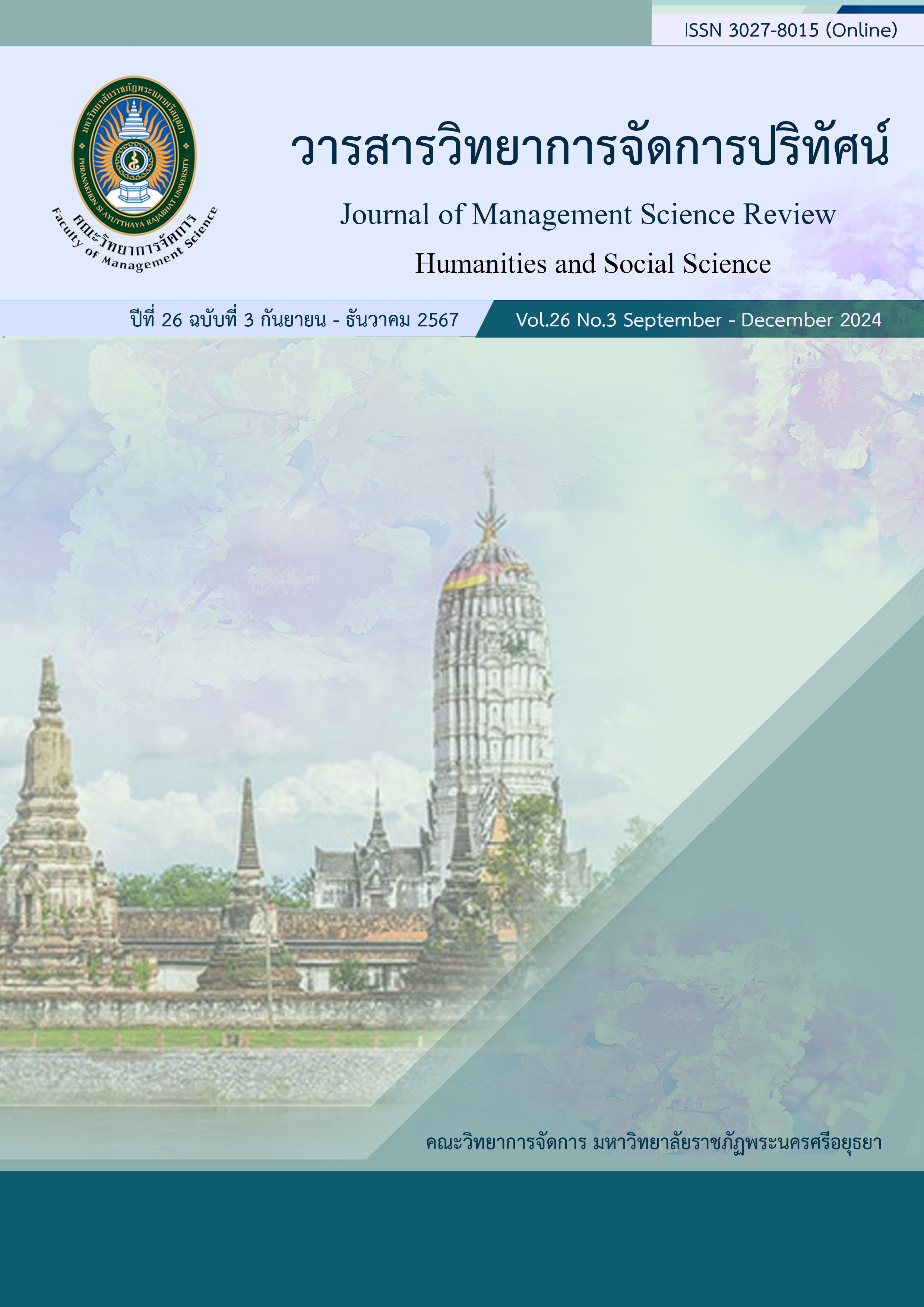Marketing Innovation Model of e–Commerce in Retail and Wholesale group with Content Digital Marketing
Keywords:
Marketing Innovation, Retail and Wholesale Trade Group, Digital Marketing, LeverageAbstract
The objectives of this research are 1) to study the management level of the marketing innovation upgrade model of electronic commerce in the retail and wholesale trade groups with content-based digital marketing; 2) to study the direct and indirect influence of Managing the model for raising the level of marketing innovation in e-commerce in the retail and wholesale trade groups with content-based digital marketing. 3) To create a management model for raising the level of marketing innovation in the e-commerce in the retail trade group. and wholesale with content digital marketing by combining quantitative and qualitative research methods. by simple random sampling A sample group of 400 people was obtained and the data was analyzed using a statistical package. The qualitative research used in-depth interviews with 9 experts and analyzed the data using content analysis. Research tools: 1) Questionnaire 2) Interview form. Statistics used in data analysis include mean, correlation coefficient, confirmatory factor analysis. The results of the study found that Strategic management level Content Digital Marketing Success Factors of marketing promotion strategies and the competitive advantage of employees in retail and wholesale businesses. The sample group had an overall average opinion level at a high level. with a value equal to 4.17 when considering each aspect, it was found that All aspects had average opinions at a high level. The side with the highest average is Digital content marketing has an average of 4.20, followed by competitive advantage. has an average of 4.19 and factors of marketing promotion strategies The mean value was 4.12, respectively, with statistical significance at the 0.05 level.
References
กัลยา วานิชย์บัญชา และฐิตา วานิชย์บัญชา. (2557). การใช้ SPSS for windows ในการวิเคราะห์ข้อมูล (พิมพ์ครั้งที่ 14). สามลดา.
การันต์ เจริญสุวรรณ และกัณฑิมาลย์ จินดาประเสริฐ. (2566). สถานการณ์การตลาดดิจิทัลของธุรกิจโรงแรมในเขตเมืองพัทยาจังหวัดชลบุรี. วารสารพิกุลคณะมนุษยศาสตร์และสังคมศาสตร์ มหาวิทยาลัยราชภัฏกำแพงเพชร, 20(2), 51-65.
เกศสิริ นวลใยสวรรค์, ทรงกลด พลพวก, วิมลกานต์ นิธิศิริวริศกุล, ฉัตรชัย ศรีมาลา, จรัญญา ไชยเสริฐ และสุเมธี เทียมสกุล. (2566). การตลาดดิจิทัลในยุคที่ท้าทาย บทบาทความได้เปรียบทางการแข่งขันของผู้ประกอบการไทย. วารสารวิจัยวิทยาการจัดการ มหาวิทยาลัยราชภัฏสุรินทร์, 7(1), 193-207.
จีณัสมา ศรีหิรัญ, ฉัตรวรุณ ศรีนาค, กวินทิพย์ เพ็งมีศรี, เปรมนีย์ ขำคม และกนกภรณ์ ครุฑภาพันธ์. (2565). นวัตกรรมการ ตลาดดิจิทัลของธุรกิจโรงแรม. วารสารวิชาการการตลาดและการจัดการมหาวิทยาลัยเทคโนโลยีราชมงคล ธัญบุรี, 9(2), 1-16.
ณัฐนันท์ กองจริต และชุติมา เกศดายุรัตน์. (2562). การศึกษากลยุทธ์การสื่อสารออนไลน์ที่มีผลต่อการตัดสินใจใช้บริการร้านเสริมสวยสัตว์เลี้ยง. ใน การประชุมวิชาการนำเสนอผลงานวิจัยระดับัณฑิตศึกษาแห่งชาติ.มหาวิทยาลัยขอนแก่น.
ธงชัย สันติวงษ์. (2548). การบริหารบุคคล. จุฬาลงกรณ์มหาวิทยาลัย.
นงลักษณ์ วิรัชชัย. (2542). การวิเคราะห์อภิมาน (Meta-Analysis). จุฬาลงกรณ์มหาวิทยาลัย.
รัชพล เตชะพงศกิต. (2560). อนาคตทรรศน์ของอุตสาหกรรมค้าปลึก มีทิศทางไปทางไหนดีถึงอยู่รอดได้. สำนักงานคณะกรรมการพัฒนาการศรษฐกิจและสังคมแห่งชาลิ
ศุภญา ดีเมฆ และพิเชษฐ์ พรหมใหม่. (2566). การตลาดเชิงเนื้อหาแบบดิจิทัลที่มีผลต่อการตัดสินใจซื้อเหล็กรูปพรรณของผู้บริโภคในจังหวัดสงขลา. วารสารอินทนิลบริหารศาสตร์, 1(1), 1-18.
สำนักงานพัฒนาธุรกรรมทางอิเล็กทรอนิกส์. (2566). ETDA เผยปี 62 คนไทยใช้อินเทอร์เน็ตเพิ่มขึ้นเฉลี่ย10 ชั่วโมง 22 นาที Gen Y ครองแชมป์ 5 ปีช้อน. https:/www.etda.or.th/th NEWS/ETDA-Revealed-Thailand-Internet-User-Behavior-2019.aspx
สุพัตรา คำแหง, สุธิกาญจน์ แก้วคงบุญ และสุภาพร ไชยรัตน. (2565). กลยุทธ์การตลาดเชิงสร้างสรรค์และการโฆษณาเชิงเนื้อหาการท่องเที่ยวโดยชุมชนจังหวัดนครศรีธรรมราช. วิทยาการจัดการวไลยอลงกรณ์ปริทัศน์, 2(2), 55-70.
อินทร์ อินอุ่นโชติ และแคทลียา ชาปะวัง. (2566). ความสัมพันธ์และผลกระทบระหว่างการตลาดดิจิทัลเชิงเนื้อหากับผลการดําเนินงานทางการตลาดของธุรกิจค้าปลีกและบริการในประเทศไทย. Journal of Modern Management Science, 16(1), 20-33.
Aaker, D., & Aaker, J. L. (2016). What are your signature stories?. California Management Review, 58(3), 49-65.
Akaeze, N. S., & Akaeze, C. (2017). Exploring the survival strategies for small business ownership in Nigeria. Australian Journal of Business and Management Research, 5(7), 35-48.
Appelbaum, D., Kogan, A., Vasarhelyi, M., & Yan, Z. (2017). Impact of business analytics and enterprise systems on managerial accounting. International Journal of Accounting Information Systems, 25, 29-44.
Bengtsson, M., & Johansson, M. (2014). Managing competition to create opportunities for small firms. International small business journal, 32(4), 401-427.
Chaffey, D., & Smith, P. R. (2022). Digital marketing excellence: planning, optimizing and integrating online marketing. Routledge.
Econsultancy. (2016). Conversion Rate Optimization Report 2016. https://econsultancy.com/reports/conversion-rate-optimization-report-2016/
Fainshmidt, S., Wenger, L., Pezeshkan, A., & Mallon, M. R. (2019). When do dynamic capabilities lead to competitive advantage? The importance of strategic fit. Journal of Management Studies, 56(4), 758-787.
Hair, J. F., Ringle, C. M., & Sarstedt, M. (2013). Partial least squares structural equation modeling: Rigorous applications, better results and higher acceptance. Long range planning, 46(1-2), 1-12.
Johnson, M. H. (2018). Essential reproduction. John Wiley & Sons.
Kucuk, S. U., & Krishnamurthy, S. (2007). An analysis of consumer power on the Internet. Technovation, 27(1-2), 47-56.
Kumar, V., & Ayodeji, O. G. (2021). E-retail factors for customer activation and retention: An empirical study from Indian e-commerce customers. Journal of Retailing and Consumer Services, 59, 102399.
Lum, C., Koper, C. S., & Willis, J. (2017). Understanding the limits of technology’s impact on police effectiveness. Police quarterly, 20(2), 135-163.
Mairura, K. O., Ngugi, P. K., & Kanali, C. (2016). The role of compatibility in technology adoption among automobile mechanics in micro and small enterprises in Kenya. International Journal of Academic Research in Business and Social Sciences, 6(5), 503-511.
Odongo, N. H., & Wang, D. (2016). Constraints in development of micro and small enterprises in the economy of Kenya. International Journal of Management Research and Reviews, 6(6), 777.
Schermelleh-Engel, K., Moosbrugger, H., & Müller, H. (2003). Evaluating the fit of structural equation models: Tests of significance and descriptive goodness-of-fit measures. Methods of psychological research online, 8(2), 23-74.
Shibia, A. G. & Barako, D. G. (2017). Determinants of micro and small enterprises growth in Kenya. Journal of Small Business and Enterprise Development, 24(1), pp. 105–118. https://doi.org/10.1108/JSBED-07-2016-0118
Singh, A. & Dwivedi, P. 2018. Methyl-jasmonate and salicylic acid as potent elicitors for secondary metabolite production in medicinal plants: A review. Journal of Pharmacognosy and Phytochemistry, 7(1), 750-757.
Too, S. (2019). Survival strategies for owners of micro and small enterprises in Kenya. [Doctoral dissertation]. Walden University.
Wairimu, Z., & Mwilaria, S. M. (2017). Microfinance institutions’ social intermediation and micro and small enterprises survival in Thika town, Kenya. Asia Pacific Journal of Multidisciplinary Research, 5(2), 87-93.




